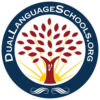Navigating the New World: Dual Language Teachers


Whether you are back in the classroom or digital learning, this year’s back to school creates unique challenges for many dual language school administrators and teachers. We invited experts from the field to share their insights on the most important things administrators and teachers should pay attention to. This is a four-part weekly series. The first 2 articles focused on dual language school administrators and these final 2 are for dual language teachers.
Rubi Flores, Director of Professional Learning, California Association for Bilingual Education (CABE)

Teachers have an opportunity to rethink the delivery of the standards in dual language programs. With schools facing shorter school days and the need to integrate asynchronous work into the daily schedule, culturally relevant thematic units or project-based learning units are a very effective way to deliver the standards in a more strategic and meaningful way.
Every year, dual language teachers eagerly await the first day of school to meet their new group of emergent bilinguals. Teachers spend part of their summer planning their instructional, behavioral, and linguistic routines to create a welcoming, yet intellectually challenging learning environment. Due to COVID-19, this year will be unlike any other as many schools will only offer virtual, or remote classes. Those returning to in-person classes will be strictly implementing social distancing measures, which will make it difficult for students to collaborate and interact as they normally would. Teaching has certainly evolved in the last few months and will continue to do so, especially in dual language programs. However, it is important to remember that there are core practices that we can continue to implement to promote the development of bilingualism and biliteracy, high academic achievement, and sociocultural competence in any instructional setting.
1. Build a Safe and Inclusive Learning Community
The first day of school can be nerve wrecking for students, parents, and even Teachers! Especially for students learning a second language. It is critical that teachers include daily opportunities to address the socioemotional needs of their students and their families. One way to address this need, would be by ensuring that there is a space at the beginning of each day to hold a community circle. Teachers can conduct community building exercises that are grade appropriate and provide mini-lessons to develop positive socioemotional skills in both languages. Teachers can also plan a weekly family community circle where parents are invited to participate in the session and showcase their language, culture, or funds of knowledge.
2. Develop Predictable Structures and Routines
Predictable structures and routines are effective classroom management strategies that allow for contextualization of the language of the classroom for emergent bilinguals in dual language classrooms. Instruction for emergent bilinguals is more effective when there is a predictable weekly schedule, familiar daily routines, and a predictable and organized way to access resources.
Teachers must make it a priority during the first weeks of school to model, explain and allow for students to practice these structures and routines thoroughly in all instructional contexts, including virtual, remote, and hybrid settings.
3. Coordinating Instruction Across the languages of the Program
Although the instructional day will vary for all programs and grade levels, it is imperative that there is an adapted language allocation plan that is aligned to the program model and articulated across the grade levels. It is recommended that students have daily opportunities to interact using the appropriate language of instruction through live interactions with teachers and peers. Other critical components to include are daily opportunities to engage in live English language development and Spanish Language development lessons that are connected to the core subjects.
4. Plan Culturally Relevant Thematic Units/ Project Based Learning
Teachers have an opportunity to rethink the delivery of the standards in dual language programs. With schools facing shorter school days and the need to integrate asynchronous work into the daily schedule, culturally relevant thematic units or project-based learning units are a very effective way to deliver the standards in a more strategic and meaningful way. Culturally relevant thematic units and project-based learning allow for integration of content and language across the content areas. This provides emergent bilinguals with increased opportunities to practice and acquire the language of the content through more concrete and meaningful experiences, especially when the units are inclusive of the cultural, linguistic, and social experiences of the students. This is also a great opportunity to include a sociocultural standards that will highlight and elevate the cultural diversity of the classroom.
5. Make Content Comprehensible
The integration of language scaffolds is essential for students participating in dual language programs regardless of the mode of delivery. Tools such as language objectives, graphic organizers, differentiated sentence frames, visual and concrete examples, modeling, talk moves, and bridging, are essential to the attainment of the three core goals of the program. These must be carefully planned using the appropriate language standards to meet the individual needs of the learners.
Dr. José Medina, Chief Educational Advocate, Author of ¡Lo que se dice, se hace!


This is equity work in the dual language classroom.
Dual language teachers are the hardest working educators. First, thank you for your service to emergent bilingual students. There is a lot of uncertainty regarding what schooling will look like in the fall. One thing we do have control over, are the lessons we plan. Whether face-to-face, remote, or a hybrid model of instruction is in place, lesson planning through an equity and social justice lens is something that doesn’t change. As you design lessons that bring together content, language, and culture, ask yourself if the lesson is amplifying the voices of communities who have been marginalized, connecting to the students and/or the real world, focusing on leveraging students’ entire linguistic repertoires, or empowering students to understand that there is no hierarchy between social and academic language. This is equity work in the dual language classroom. Please also visit the duallanguageschools.org YouTube channel where you can find short videos focusing on the C6 Biliteracy Framework which guides this important lesson planning work in dual language.
Lisa Tabaku- Director for Global Languages and Culture at CAL

With the comfort and support DL teachers offer to each other, these hurdles will be more easily surmounted.
My advice for teachers hinges on my observation that DL teachers are special; they go above and beyond even under “normal” circumstances to ensure that their students become bilingual and biliterate, reach high academic levels in both languages, and gain socio-cultural competency. Mirroring the advice for school leaders, teachers will serve their students best when they take a collaborative and caring approach to confronting the challenges caused by COVID-19. There will be numerous hurdles: allegiance to language allocations; the identification, support, and use of virtual learning tools that serve language learners best (if distance learning will be part of the equation); plans for effectuating distancing and safety measures inside school; and clear communication with and involvement from families, to name a few. With the comfort and support DL teachers offer to each other, these hurdles will be more easily surmounted.
Cheryl Urow, Co-Founder at Teaching for Biliteracy


What is critical is that families feel seen and heard and know that their students will be engaging in robust dual language learning.
As always, focus the beginning of the year on establishing relationships with the students, their families, and in creating a classroom community. Try to meet with each student and family individually and, engaging in the language most comfortable for that family, create a shared understanding for the upcoming year. This might be the time to help families understand the virtual platform, or to review the schedule. What is critical is that families feel seen and heard and know that their students will be engaging in robust dual language learning.
Sandra Mercuri, Educational Consultant & Author of Pathways to Biliteracy


Engage students in crosslinguistic connection conversations about similarities and difference across the two program languages.
Teachers should ensure:
1. Adherence to the time and content allocation across the two modalities of delivery and across both program languages.
2. Alignment of face-to-face classroom and virtual environments so that all students have access at the same resources regardless if they attend school face-to-face, hybrid or virtually.
3. Strategic planning to foster linguistic equity through remote learning and face-to-face across the two languages to facilitate oracy. In order to help students further develop their linguistic competencies teachers can:
1. Explore different digital tools to scaffold language, shelter instruction, and ultimately foster biliteracy.
2. Engage students in meaningful ways to use academic language.
3. Provide linguistic scaffolds such as sentence structures.
4. Select chants and song to teach literacy and biliteracy and to enhance oracy development.
5. Engage students in crosslinguistic connection conversations about similarities and difference across the two program languages.
6. Create small groups for live sessions as well as one to one support for students who need it.
7. Distribute the teaching and learning of skills across the week considering the demands of virtual teaching and learning.
8. Include culturally relevant texts that allow students to engage in critical conversations out current realities as they interact with their classmates from different cultural background and experiences
9. Analyze assessment side-by side from a holistic perspective to identify what students can do in one language and use that knowledge to support students’ access to knowledge in the partner language and vice versa.
Joan LaChance, Associate Professor of TESL & co-author of The Dual Language Education Teacher Preparation Standards©


I would say “think outside the box” as much as you can. School as we know it has transformed quickly into something that has a very different shape.
Try to know as much as you can about your students and what they have access to while outside of school. If they are to have periods of remote learning mixed in with face to face schooling, the more you know about their home contexts the better. That way you can tap into strengths for project-based learning in the event they can’t be online every day. Also–I would say “think outside the box” as much as you can. School as we know it has transformed quickly into something that has a very different shape. Working across the content standards via cross curricular projects will be important to maximize content and language learning. Keeping kids engaged with each other in safe ways will ensure they remain motivated to use new language in new ways.

